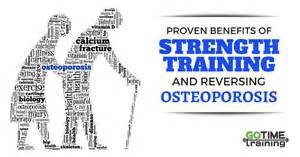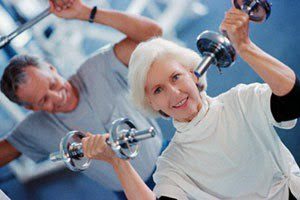by: Kyle Factor
Osteoporosis is a disease in which bones begin to lose mass and density due to many lifestyle and genetic factors leading to frailty of the bones and a higher risk of fracture or breaks. Osteoporosis is a disease that is very prominent among older individuals. However, there are also some risks associated with exercise when it comes to individuals with this condition. The risk of breaking a bone puts a damper on heavy lifting, highly intense cardio, and many activities of daily living that most people take for granted. Older individuals tend to look toward recreation for their main source of exercise. Older individuals affected with disease may experience negative impacts on physical fitness and psychological efficiency due to this condition.
When trying to weigh the risk versus reward for exercise with this disease, you have to set the main goals first. The first goal is to maximize balance and coordination. There is a tremendous risk with falling and breaking bones. The second goal is to build muscular strength. Muscular strength helps the individual perform daily tasks that put stress on the body. With muscular strength, comes more muscular mass and protection of the bones. The third goal is mobility. Many different aspects go into mobility such as, flexibility, coordination, and stability. It is important for individuals with this disease to have a good base of stability with lower body strength to help prevent falls.
- Maximize balance and coordination- This can be achieved with resistance training exercise and functional training
- Build Muscular Strength- Resistance training
- Mobility- Muscular conditioning, flexibility training, ADL’s
Some recommended training options for these individuals would be low intensity exercise. Low weighted resistance exercises have been shown to have positive effects on bone mass in the spine.
- Resistance training should be done 2-3 time a week in 20-40 minute sessions.
- Aerobic training can be used safely with cycling, elliptical, swimming, and walking. This training should be done at 40-70% peak HR , 3-5 days a week, and around 30 to 60 minutes per session. All of these methods help are low impact.
- Flexibility training is most effective when done every single day. Stretching the joints and muscles, holding for 30 seconds each stretch help increase range of motion.
Osteoporotic individuals can be very high functioning individuals if they keep proper nutrition and prepare their bodies physically for everyday life. Though there are many negative side effects of the disease, minimizing the risk factors has been shown to help individuals lead a more positive life. Some of the ways to minimize the risk factors for this disease:
- Exercise regularly
- Lower caffeine intake
- Be at a healthy weight
- Have a healthier diet
- Take calcium supplements

